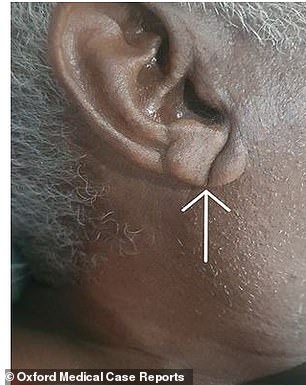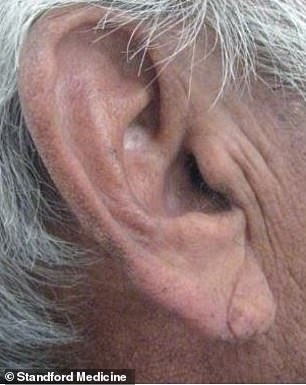A subtle but visible change in the skin of the earlobe is a sign of heart disease, indicating a person is at risk of a heart attack or stroke, research shows.
Doctors may examine the earlobes of patients suspected of having heart problems to detect a diagonal crease that runs back across the lobe at a 45-degree angle.
Known as Frank’s sign or diagonal earlobe crease (DELC), the longer and deeper the crease, the greater the risk, studies have shown.
Patients with folds on both earlobes and multiple folds are also considered to be at greater risk.
Celebrities mentioned in the medical literature as having DELC include former President George W. Bush, who, despite being known as an avid runner and mountain biker, was diagnosed with cardiovascular disease.
President George W. Bush was diagnosed with cardiovascular disease in 2013 despite being an avid runner and mountain biker.

Doctors may examine the earlobes of patients with suspected heart problems to detect a diagonal crease that runs backward across the lobe at a 45-degree angle. Known as Frank’s sign or diagonal earlobe crease (DELC), the longer and deeper the crease, the greater the risk.
In 2013, President Bush reportedly underwent a routine exam that revealed “a serious blockage” in one of the arteries supplying blood to his heart.
He underwent angioplasty, a procedure in which a stent (a mesh metal tube) is implanted into the blocked artery to restore circulation.
Actor James Gandolfini, who played Tony Soprano on the long-running HBO series The Sopranos, died of a heart attack in 2013, and also appears to have a DELC.
Oscar-winning film director Steven Spielberg is also cited in several medical journals as having a visible DELC, although he has never publicly said he has heart disease.
The phenomenon was first described in 1973 by pulmonary specialist Saunders T. Frank—hence the name—who observed the diagonal line in patients with chest pain due to angina.
Since then, numerous studies have found someone with DELC to have confirmed the association.
78 percent of patients who suffered a fatal heart attack were also found to have DELC.
The reason why people with heart disease may develop this crease is not fully understood, but it could be due to changes in the small blood vessels that supply the ears.
There may also be a genetic reason: those who are predisposed to heart disease also have genes that code for wrinkles and creases in the earlobes.

Actor James Gandolfini, who played Tony Soprano on the long-running HBO series The Sopranos, died of a heart attack in 2013, also appears to have a DELC

The phenomenon was first described in 1973 by lung specialist Saunders T. Frank—hence the name—who observed the diagonal line in patients with chest pain due to angina.

Oscar-winning film director Steven Spielberg is also cited in several medical journals as having a visible DELC, although he has never publicly said he has heart disease.
Research has shown that Japanese and Chinese men do not appear to develop DELC.
Tim Chico, professor of cardiovascular medicine at the University of Sheffield, said DELC was “something cardiologists were familiar with” and “made sense”.
He added: ‘Cardiovascular disease is not just something that affects the heart, it affects all the blood vessels in the body and all the organs.
‘It increases the risk of heart attacks and strokes, but also kidney disease and even dementia.
“If we see DELC in a patient, it doesn’t change the advice we give them. Risk is reduced by not smoking, maintaining a healthy weight, eating a balanced diet and exercising regularly.”
Heart disease is responsible for around 68,000 deaths in the UK each year, or an average of 190 people every day.
In the United States, one person dies every 33 seconds from cardiovascular disease (approximately 700,000 per year).
Other visible manifestations of heart disease include xanthelasmas, small yellow bumps that form around the inner part of the eyes.


It’s not clear why people with heart disease develop this crease, but it could be due to changes in the tiny blood vessels that supply the ears. There may also be a genetic reason: people who are predisposed to heart disease also have genes that code for wrinkles and creases in the earlobes.
These usually appear along the corners of the upper and lower eyelids and are a sign of high cholesterol.
Other indicators of high cholesterol include arcus cornealis, a white or pale gray ring around the iris.
High blood sugar and diabetes risk are associated with darkening and thickening of the skin in “fold areas” such as the nape of the neck, armpits and groin, known as acanthosis nigricans.
It is also well known that obesity is associated with an increased risk of heart disease, heart attacks and strokes, as well as a host of other health problems.


